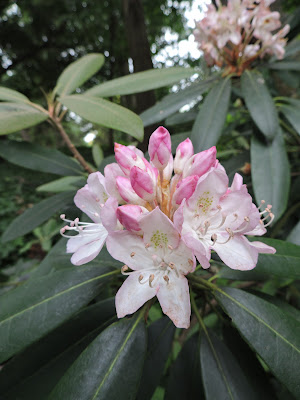 |
| A Wood Frog with its typical dark, raccoon-like bandit's mask. |
Wood Frogs (Lithobates sylvaticus) are not the typical frogs that come to mind when people think of frogs. For one, they are the most cold tolerant of all North American frogs, being the only American species found north of the Arctic Circle. They can tolerate having substantial parts of their bodies frozen with out harm and are usually the first frogs to breed every year. Wood Frogs can do this due to the production of high levels of glucose in their blood and other adaptations. This allows these amphibians to come out despite the fickle weather conditions of early spring and survive not only very low temperatures, but sudden decreases that would kill most other amphibians. Indeed, I've seen them when their ponds still have ice on them and seen them hopping through the snow after a sudden temperature drop has caught them away from shelter.
As their common name suggests, Wood Frogs live in woodlands, under leaves and in other animals' burrows, but need to return in the early spring to lay their eggs in vernal pools. Breeding starts after the first sustained, warm rains of spring, normally in late February or early March around the DC region. They are among the first vernal pool species to come out of their winter torpor (called brumation) look for their natal pools.
Vernal pools are for the most part temporary, drying up in the heat of the summer. This means they cannot support fish and some other pond species. Because wood frogs tadpoles do not compete well with fish (or even other tadpoles), they rarely lay their eggs in waters containing fish, which consume their young readily. Instead, like other vernal pool species, they gamble on being able to go through metamorphosis before the pools dry up. Some years many do, other years none. Luckily, they are explosive breeders, and so, as long as the habitat remains suitable, they usually have enough good years to make up for the bad ones they always suffer. Their habitat though has to contain both established woods along with temporary pools.
 |
| Multiple Wood Frog egg masses laid communally in a vernal pond. |
Female Wood Frogs are larger than the males to allow them to carry more eggs, up to 3,000 at a time. These are are often laid communally. They can take some cold and perhaps gain some protection from being mostly laid close together. Because they also often have certain unicellular algae that grow on them, they can be well camouflaged. The algae is also suspected of providing oxygen to the developing embryos. Depending on water temperature, tadpoles can emerge very quickly. I've had them born with 3 days of being laid in warm room conditions. Upon first emerging from their jelly-like egg mass, they are very dark. This perhaps helps them retain heat better. They change to a lighter color as they mature.
 |
| A late stage Wood Frog tadpole. |
The tadpoles mostly feed on algae and detritus, but have been known to scavenge and even feed on toad tadpoles. The warmer the water and more food that is available, the faster they mature. They can metamorphose into froglets in under 2 months. They can also speed up their metamorphosis if the pool starts to dry up, though the smaller froglets that emerge are at a competitive disadvantage. Siblings from the same egg mass seem to recognize each other and stick together. Though distasteful to some predators, fish gobble them up. Under ideal conditions, they can be quite numerous, as this short video shows:
https://www.youtube.com/watch?v=a7cwRBAqAYk
They look really neat underwater: https://www.youtube.com/watch?v=vw2y9TlrlKA
These frogs are various shades of brown, normally 2-3" and sport a dark bandit's mask. They are good jumpers and also good at concealing themselves in the forest duff. Indeed, they're rarely seen outside the breeding season at their vernal pools. Adult Wood Frogs can alter their body color somewhat. They get very dark when they first arrive to their ponds and when they're cold. If they're lucky, they can live 4-7 years, with the larger females living longer and needing an extra year (or 2 at higher elevations) to mature.
 |
| A mating pair of Wood Frogs in amplexus, the smaller male on top. |
These are one of the first signs of spring for many naturalists, the males giving their duck-like "craw-awk" calls during any wet, warm spell in early spring. They can gather in huge numbers, but just as quickly disappear as soon as the weather changes or they're done breeding. To me, they signal that many more spring signs are on the way, but these cold-hardy amphibians are among the first to brave the worst weather. Being around on a "big night" (as herpetologists sometimes call when conditions are just right) and when they are migrating in large numbers is a truly wonderful experience. This is well worth braving the cold rain that usually accompanies them. Here's a video of a chorus of Wood Frogs from the Capital Naturalist YouTube Channel for your enjoyment:
https://www.youtube.com/watch?v=eCo_J1__Qxo
 |
| A pond full of the eye-shine of Wood Frogs on a "big night" |
successful restocking effort: https://www.youtube.com/watch?v=aaQxe35yuDQ

















